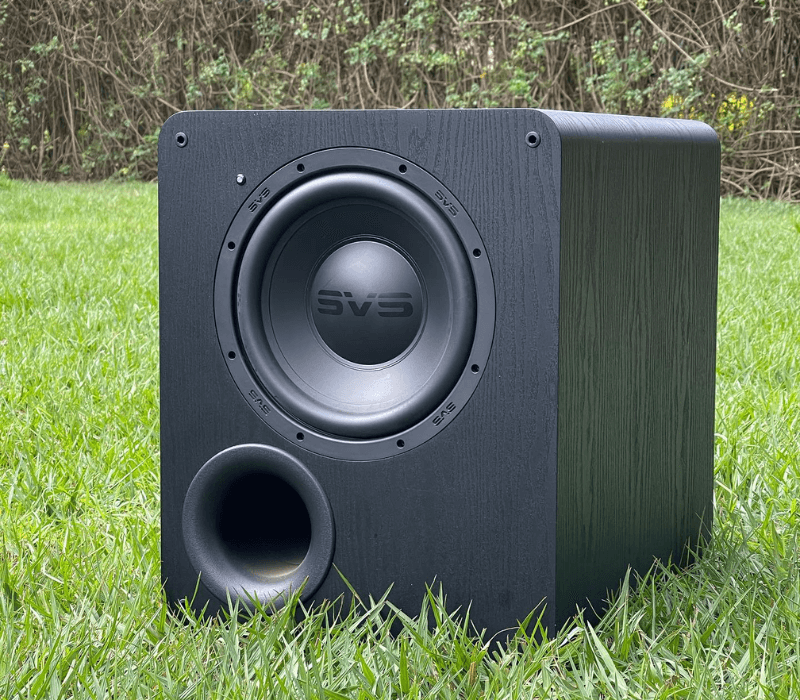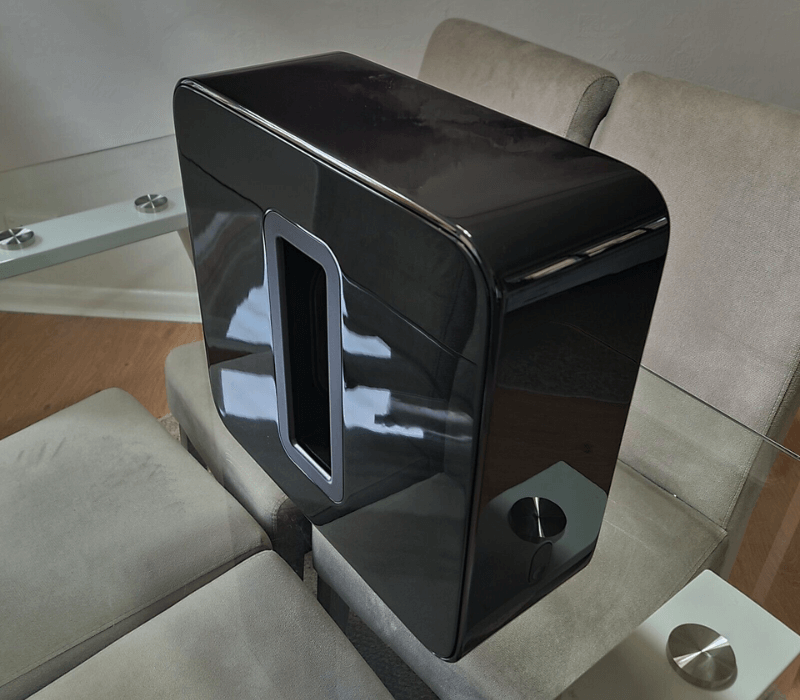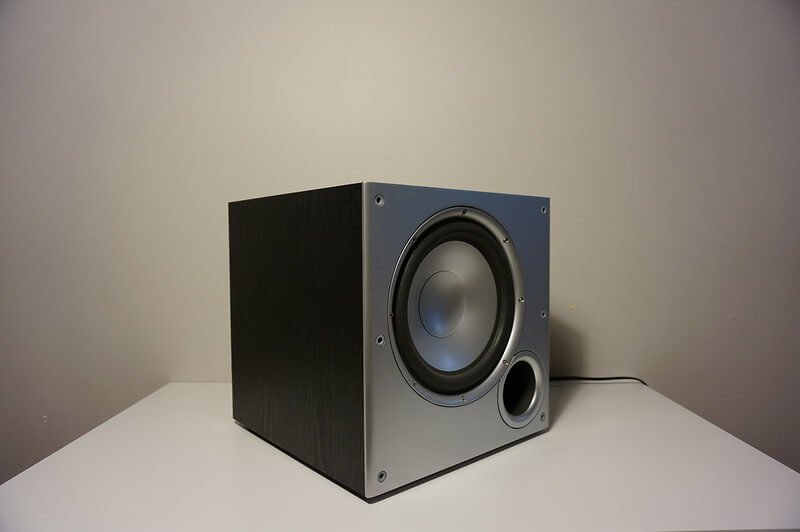A subwoofer is a type of speaker designed to reproduce the low frequencies in your stereo or home theater system. The subwoofer improves your system’s audio performance to make it more immersive. If you love watching movies or listening to music via full-sized speakers, a subwoofer will greatly benefit you.
If you’re looking for a good subwoofer, there are different things you’ll need to check. In this article, I’ll break down how to choose a subwoofer. I’ll cover everything from sound quality, features, volume, cost, etc.
1. Sound Quality Matters
Like speakers and headphones, the sound quality of a subwoofer is one of the most important qualities you’ll need to consider. A subwoofer handles the low frequencies in a sound frequency. With any dedicated subwoofer, there will be an improvement in the bass quality. However, a good subwoofer’s transient response is usually evident during busy action scenes. It can keep up with speakers without sounding unnatural or distracting.

SVS PB-1000 Subwoofer
The frequency range extension also determines how immersive the subwoofer will get. We, humans, can hear sounds in the range of 20 Hz to 20 kHz. However, the sounds are felt rather than heard as you go down the frequency range. The lower the subwoofer’s frequency range, the better it will rumble. Most expensive subwoofers, such as the SVS PB-3000 or Power Sound Audio S3611, can go down to about 16Hz. However, a subwoofer that reaches 25Hz is good and will be relatively inexpensive.
Apart from the transient response and frequency range, other qualities, such as driver type, driver size, power, and much more, affect the sound quality. Depending on these different factors, you can get the best sound quality for you. As you read through this article, I’ll cover some of these topics to help you decide when choosing a subwoofer.
2. The Size of the Subwoofer
The size of the driver determines the size of a subwoofer. The driver is the subwoofers’ speaker, the circular cone reproducing sound. The size of the subwoofer’s driver will determine its energy, volume, and also its enclosure size. A larger subwoofer driver will be more powerful, sound louder, and have a bigger cabinet.
For an average-sized home, a 12-inch subwoofer is a good standard. 12-inch subwoofers are also the most common subwoofer size you’ll find around that fits the budget. However, if you need more power or have a larger-sized room, a larger-sized subwoofer, like 15 inches or more, will serve you better.
Apart from the power and volume, some factors, such as transient response, will be affected as the size gets bigger. An 8-inch subwoofer might have a faster transient response than a 15-inch subwoofer.
3. Subwoofer Power Handling and Volume
A subwoofer’s power handling or wattage rating is what determines the power and volume level it gives out. When talking about subwoofers, you’ll hear most users mention ‘watts,’ which refers to a way of measuring its power. A higher wattage subwoofer is more powerful and will play sound louder. However, when checking the wattage, look for RMS, which is Root mean square and Peak Watts.
RMS refers to the continuous power handling of the subwoofer. This is the most important feature to look for when choosing a subwoofer because it represents what your subwoofer can handle without degrading the sound quality.

KEF KC62
Peak power handling represents the highest power level a subwoofer can handle without destroying the driver. While most manufacturers will emphasize the peak power, this does not accurately represent how the subwoofer will perform every time. Instead, I advise you to avoid looking at the peak power when choosing your subwoofer.
Instead, focus on the RMS, which shows how much power the subwoofer can put out when driven to a reasonable volume. The higher the RMS wattage, the more likely your subwoofer will play clean, undistorted audio, even at higher volumes. The higher the RMS wattage, the more expensive a subwoofer will be. An RMS wattage of 150-500 watts for most subwoofers is a good balance.
4. Active vs. Passive Subwoofer
Depending on your home theater setup, you can get an active subwoofer (powered) or passive subwoofer.
Active or powered subwoofers come with an inbuilt amplifier that is already matched to power the subwoofer properly. This eliminates the need for an external amp and the hustle of matching the amplifier to a subwoofer for optimum performance. Another advantage is that you’ll have fewer cables to worry about since you’ll only need a single cable from your amp or home theater receiver.
Passive subwoofers need to be powered by an external amplifier or AV receiver, which is like traditional speakers. Because a passive sub requires more power, you’ll need a powerful amp to power it sufficiently without straining it. You’ll also have to match the amp to the subwoofer for optimum performance.
I recommend using a powered subwoofer for a beginner looking to build their system. There are not many customizations, and setup is also easier. However, if you’re a pro building a custom home theater system, a passive subwoofer is cheaper than active subwoofers. Check out our in-depth article on active vs passive subwoofers.
5. Wired vs. Wireless Subwoofers
Wired subwoofers must be connected to a power source to draw power and to an AV receiver or amplifier to receive sound. This requires the use of cables that might run through the room for successful connections. A power cable and some RCA or sub preamp/LFE inputs are what you usually require to connect a sub to your amp/receiver successfully.

Sonos Wireless Sub
However, you’ll only require a power cable for wireless subwoofers, and you’re good to go. Some good examples of wireless subwoofers include the likes of the Sonos Sub and Klipsch R-121SW. Wireless subwoofers work by connecting to the audio source via Bluetooth or Wi-Fi. The subwoofer has a receiver that receives and decodes digital audio from the transmitter on your audio source. For more on wireless subwoofers, check out our best wireless subwoofer.
While wireless subwoofers are gaining popularity, the good news is you can make your wired subwoofer wireless too. You’ll need a wireless subwoofer adapter like the SVS sound path, which includes a transmitter and receiver. Connect the transmitter to your audio source and the receiver to your subwoofer and pair them to complete the connection.
6. Sealed vs. Ported Subwoofer Design
The drivers of a subwoofer behave differently based on the enclosure. Cabinet size, tuning, and other mechanical stuff will all affect the overall sound of the subwoofer.
A sealed subwoofer encloses the driver with no air coming in or out. A ported subwoofer has one or several ports that allow both sound and air to go in and out of the subwoofer’s enclosure. Apart from the design of the subwoofer’s enclosure, the difference between sealed and ported subwoofers is their sound quality.

Polk Audio PSW Series PSW10 Powered Subwoofer
Sealed subwoofers have a tight, even, and well-controlled bass response, while ported subwoofers are powerful and can sound louder. For a larger room, get a ported subwoofer, but a smaller setup will benefit from a sealed subwoofer. The design of the ports will also affect the overall frequency response of the subwoofer.
7. Front- vs. Down-Firing Subwoofers
The firing direction of a subwoofer is the direction where its main driver is facing. Front-firing or side-firing subwoofers have the driver facing front or side, where the sound radiates. Down-firing subwoofers have the drivers facing down, so the sound from the sub radiates from the floor.

SVS SB13 Ultra with SoundPath Isolation System
The difference in sound quality between a subwoofer’s firing direction is minimal. This is because low frequencies are non-directions, so it’s harder to pinpoint the direction the sound is coming from. However, depending on your home theater setup and sub-placement plan, you can better choose between the two firing directions.
8. One Subwoofer vs. Two Subwoofers
Most AV receivers allow you to connect more than one subwoofer when building your home theater setup. However, do two subwoofers make the bass better and more immersive?
Two subwoofers are better than one because they’ll even out the bass response for a better and smoother sound. One subwoofer is better for a smaller room and will deliver a good bass response. However, if you have a larger room or want an even bass response, two subwoofers will be better than one.
9. The Cost of Subwoofers
The higher the price of the subwoofer, the more features, power, and output wattage you’ll get. However, spending thousands of dollars on a subwoofer is only advisable if you have a larger room and a good system to complement the sub. For most homes, a subwoofer between the $200 and $1000 range is filled with many good options.
I would not advise going for a cheaper subwoofer under $150. I’ve listened to most of these cheap subwoofers, and the sound quality is unreliable to give the best results. Depending on the power, driver size, frequency response, and type of subwoofer, something will always satisfy your sound buds. The most popular subwoofer size for most homes, 12 inches, costs about $250 on average from most brands.